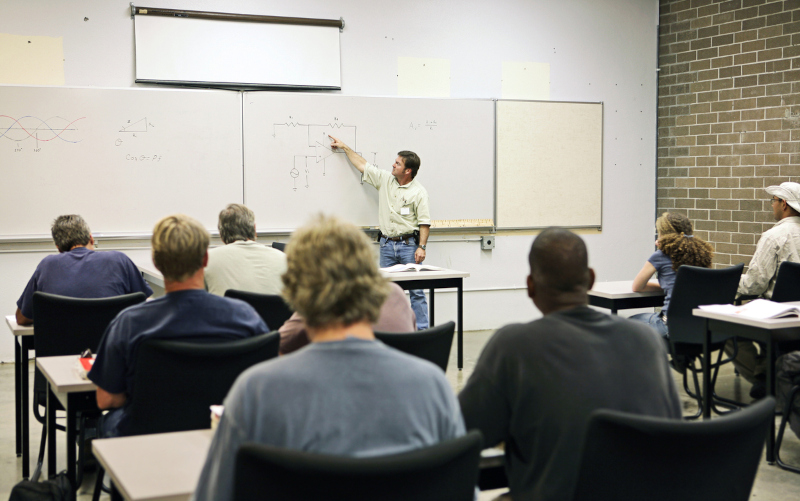Time to get serious about ventilation and air quality in training and post-secondary education
July 16, 2022
Australia is not doing enough to improve clean air in post-secondary education and training environments. Given the COVID-19 pandemic will be with us for a very long time to come, training providers and universities need to invest more in ventilation and air quality to ensure that students can learn in the safest environments possible.
The pandemic is not over, but many act as if it is. If it were over, Australia would not have had more than 10,000 COVID deaths the majority of them this year with hospitalisations soon to peak higher than the January Omicron wave.
Nor would Australia’s vocational education and training (VET) system more dependent on in-person learning than universities have experienced a significant drop in the numbers of Australians participating in formal training, down 6.4% in 2020 from 2019, numbers that would have been much worse had governments not poured money into online TAFE short courses.
This drop in student numbers is especially marked for “disadvantaged Australians [who] face triple jeopardy low vaccination rates, greater likelihood of being infected with COVID-19, and higher risks of serious disease and death from COVID-19.” ABS data shows that the lowest income Australians (bottom SEIFA quintile 20%) are more than three times likely to die from COVID than the most wealthy (top quintile). Disadvantaged Australians have also disproportionately withdrawn from training during the pandemic, with many reluctant to return.
Investing in air quality in educational settings is a no brainer
With governments unwilling to mandate mask-wearing in all indoor environments, “investing seriously in improving indoor air quality. needs no social licence, it should be done immediately,” write Professors Brendan Crabb and Mike Toole. The multi-disciplinary Australian expert group OzSAGE has issued air quality guidance which states:
“Ventilation is key to our exit strategy. Schools and businesses have immediate needs for better ventilation, and urban design needs to incorporate improved airflow in a post-COVID world. SARS-CoV-2 spreads through the air. The risk of COVID-19 infection is higher in indoor spaces, and it’s even higher when those indoor spaces are poorly ventilated. In this context, ventilation means provision of safe, clean indoor air.”
One Australian, Professor Lidia Morawska from QUT, was even been identified by Time magazine as one of the “100 Most Influential People in the World” in 2021 for her advocacy to recognise aerosols and make air cleaner. (She will speak at CCA’s upcoming September conference). Overseas research and modelling have reinforced the value of ventilation improvements: an American study “found that the incidence of the virus was 35% lower in schools that had improved their ventilation by opening windows or doors or using fans than in schools that did not. In schools that combined better ventilation with air filtration [such as] HEPA filters, case rates were 48% lower.” (The addition of masks for teachers and staff members reduced the virus incidence by a further 37%.)
Australian governments have recognised the value of investing in ventilation and air quality in educational settings, with Victoria leading the way in late 2021 with a roll-out of more than 50,000 air purifiers to schools. Professor Mike Toole believes these additional air filters contributed to that state’s lower COVID-19 hospitalisation rate in early 2022. The Victorian Government has followed up with a $60 million Small Business Ventilation Program to help eligible public-facing small businesses to improve building ventilation in areas accessible to customers and reduce the risk of spreading COVID-19.
A national schools ventilation program
OzSAGE called for a national schools ventilation program in September 2021. In January 2022, then Opposition Labor committed to a $240 million Schools Upgrade Fund to upgrade “make sure all kids can learn at world class schools with great facilities in a COVID-safe environment” which will “improve ventilation and air quality by buying air purifiers, upgrading heating, ventilation, and air conditioning systems, building outdoor learning spaces and replacing windows and doors so they can let fresh air in.” The Victorian program provides a national model for the new government to follow.
What’s happening in VET and universities?
Consideration of air quality and ventilation in VET providers and universities appears to lag behind the schools sector. There are notable positive examples: Australian National University has implemented changes to ventilation in all buildings across campus. The university’s Vice Chancellor reports a dramatic reduction of COVID-19 on campus, due to classroom ventilation upgrades combined with masking and vaccination what OzSAGE refers to as a “Vaccine-Plus” strategy.
The COVID prevention challenges in vocational education are greater: many VET activities are practice-based in physical environments, less able to pivot to online learning; there are more than 4,000 individual VET providers in Australia many of them small and located in outer suburban and regional areas; VET students are often not as wealthy as university students, with resulting less access to high-quality computing, broadband and even private transport; and VET funding has lagged behind other educational sectors for many years, reducing the capability of many providers to adjust to the pandemic’s challenges.
Small initiatives work, however. The NSW Government funds 32 adult and community education (ACE) providers to deliver both accredited and non-accredited education and training, much at the “foundational skills” level to many vulnerable and disadvantaged groups. Last year, the NSW Department of Education allowed ACE providers to convert some funding to essential infrastructure for training disadvantaged groups, including improvements in ventilation and air quality. According to research by Community Colleges Australia, some 80% of the NSW ACE providers upgraded air quality in training environments, most of them using state funding.
That’s a great start, but much more needs to be done. With Australia facing a dramatic increase in respiratory (COVID and flu) cases in July into August and COVID due to hang around for years an investment in safe adult learning environments that matches our concern for schools is long overdue.

